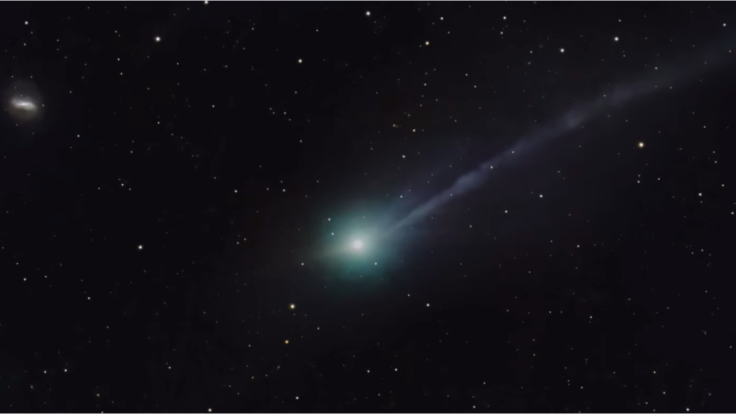3I/ATLAS Update: Amateur Footage Captures 'Spinning' Motion Before NASA Event

New amateur videos of interstellar comet 3I/ATLAS have ignited fresh debate after backyard observers claimed the rare visitor appears to be rotating.
The clips are circulating widely online just days before NASA unveils its most detailed multi-mission images of the object, intensifying public fascination with one of the most unusual interstellar bodies ever detected.
Amateur Observers Claim the Comet Is Rotating
In a YouTube clip titled 'Comet 3I Atlas is SPINNING – I took a picture', astrophotographer Ray says the object's coma shows 'subtle, continuous motion' that he believes is consistent with rotation.
The footage has attracted thousands of views and sparked debate among hobbyists and sceptics trying to assess whether the effect is real or simply a product of long-exposure imaging.
Another widely shared video, 'REAL FOOTAGE of Interstellar Comet 3I/ATLAS?! Or ...', makes a similar claim, with the narrator asserting that a 'rotation anomaly stuns astronomers worldwide.'
The speculation has added fuel to online discussions, reflecting growing public fascination with the rare interstellar object.
Astronomy hobbyists are now trying to determine whether the apparent motion reflects genuine rotation or is simply an artefact of long-exposure photography, atmospheric distortion or tracking drift.
The debate has surged across Reddit, X and YouTube forums, echoing the public curiosity seen during the arrivals of 'Oumuamua and 2I/Borisov.
Speculation Reignites — And Avi Loeb Weighs In
The online chatter has revived debate about what 3I/ATLAS actually is.
Harvard astrophysicist Avi Loeb--known for raising unconventional hypotheses about interstellar objects--wrote in his Medium blog 'Do the Anomalies of 3I/ATLAS Flag Alien Technology or an Unfamiliar Interstellar Iceberg?' that if the rotation seen in amateur footage proves genuine and is combined with the object's other unusual behaviours, 'the object might not be a typical comet.'
Loeb suggested that the anomalies could be produced by 'directional thrusters,' a claim picked up by science news sites such as Futurism.
His comments have predictably stirred debate within the astronomy community.
Most scientists, however, maintain that 3I/ATLAS is behaving like an interstellar comet.
LiveScience addressed the speculation directly, reporting that 'no, comet 3I/ATLAS hasn't exploded--and no, that doesn't mean it's an alien spaceship'.
NASA Prepares Major Image Release
NASA will release new, high-resolution images of 3I/ATLAS during a live briefing at 3 p.m. EST on 19 November, streamed from the Goddard Space Flight Centre.
The images come from multiple missions and observatories, giving NASA what Space.com describes as a 'unique capability to study how the comet behaves.'
The reveal will stream on:
- NASA+
- NASA app
- NASA.gov
- YouTube
- Amazon Prime Video
The timing of the amateur footage has heightened anticipation for the agency's update.
What Scientists Know So Far
3I/ATLAS—formally C/2025 N1—was discovered on 1 July by the ATLAS survey telescope in Chile. It is only the third confirmed interstellar object ever observed.
Key scientific findings include:
Cometary Structure Confirmed
- A Hubble image from 21 July shows a teardrop-shaped dust cocoon typical of active comets.
- NASA stresses it poses no threat to Earth, passing at a distance of roughly 170 million miles.
Unusual Optical Properties
- Observatories including VLT, NOT, and Rozhen detected extreme negative polarisation, rare among solar-system comets.
Carbon-Rich Composition
- James Webb Space Telescope spectroscopy finds the coma dominated by CO₂, with water, CO, and OCS also present.
Possible 16-Hour Rotation
A separate photometric study suggests a rotation period of about 16 hours, though researchers say more observations are needed.
3I/ATLAS's Rotation and Composition
Preliminary studies of 3I/ATLAS are revealing unusual features that set it apart from typical comets.
Observations with telescopes such as the Very Large Telescope (VLT), the Nordic Optical Telescope (NOT), and the RCC telescope at the Rozhen Observatory reveal what scientists describe as an 'extreme negative polarisation,' an optical signature not seen in ordinary comets.
Spectroscopic data from the James Webb Space Telescope indicate the comet's coma is dominated by carbon dioxide, with additional detections of water, carbon monoxide, and OCS.
Researchers point to a volatile-rich composition that may differ from comets formed in the solar system.
A separate photometric study suggests that 3I/ATLAS has a rotation period of roughly 16 hours, though scientists caution that further observations are needed to confirm the measurement.
Why the Amateur Footage Matters--and What's Next
The amateur videos add a relatable human layer to a story driven mainly by high-precision instruments and technical data.
Observers like Ray, who filmed the supposed rotation from his backyard telescope, are helping steer public curiosity toward one of the rarest types of objects humans have ever detected.
As the NASA image release approaches, astronomers say the new data could help determine whether the 'spinning' seen in amateur clips reflects a real physical process or is simply an artefact of exposure, perspective, or image processing.
The 19 November briefing may not answer every question. Still, it is expected to provide the most explicit pictures yet of 3I/ATLAS--and may mark a turning point in understanding the nature of the mysterious interstellar wanderer.
© Copyright IBTimes 2025. All rights reserved.




















